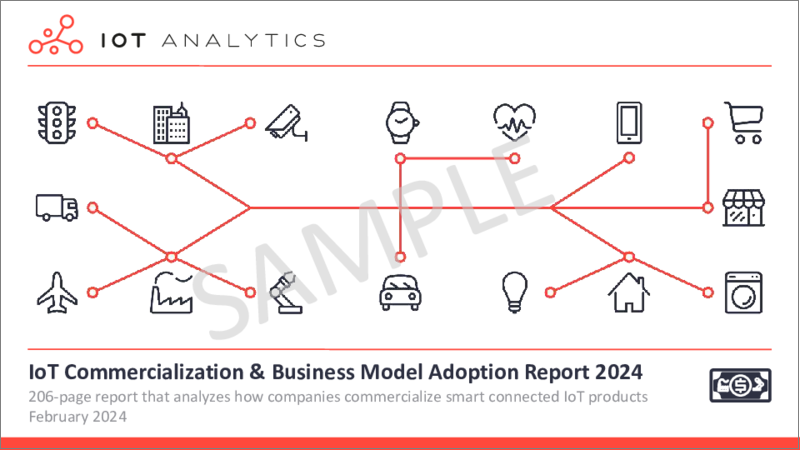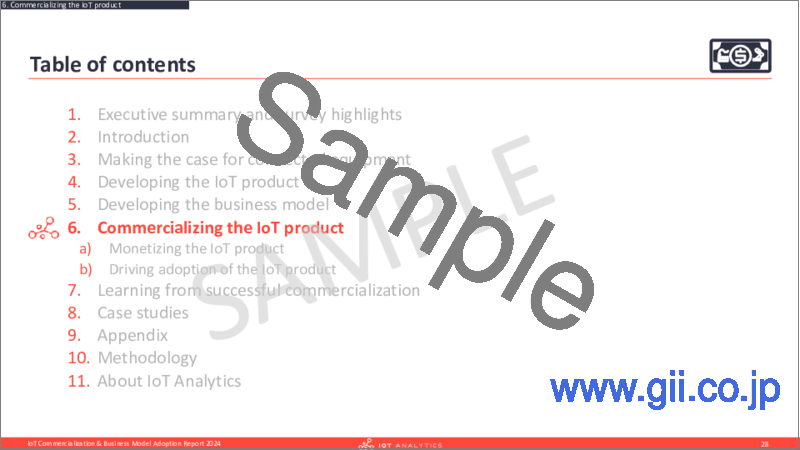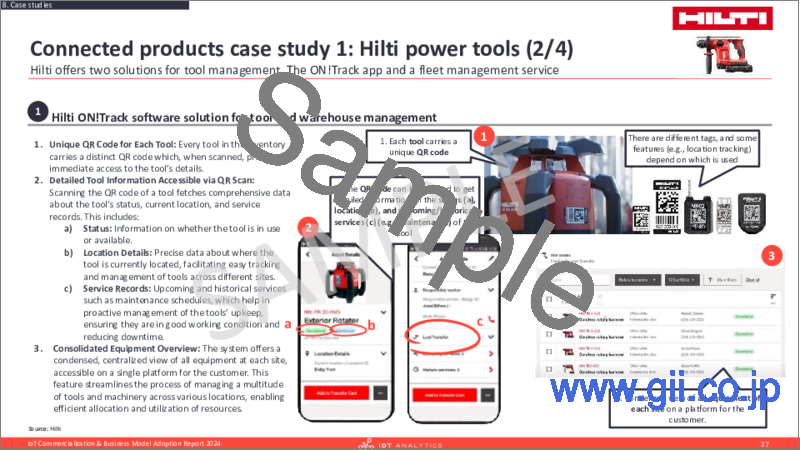|
|
市場調査レポート
商品コード
1420453
IoTの商業化&ビジネスモデル導入:2024年IoT Commercialization & Business Model Adoption Report 2024 |
||||||
|
|||||||
| IoTの商業化&ビジネスモデル導入:2024年 |
|
出版日: 2024年02月05日
発行: IoT Analytics GmbH
ページ情報: 英文 206 Pages
納期: 即日から翌営業日
|
全表示
- 概要
- 目次
当レポートでは、スマートコネクテッドIoT製品の商業化プロセスを6つの主要セクションに沿って分析し、成功の特徴やパターン、陥りやすい落とし穴、ケーススタディなどをまとめています。本レポートに掲載されている情報は、2023年第3四半期にスマートコネクテッド製品のOEM100社を対象に実施した広範な調査に基づいています。
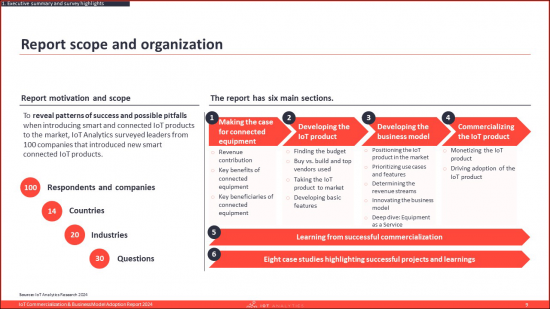
成功プロジェクトと得られる学びに焦点を当てたケーススタディ
サンプルビュー
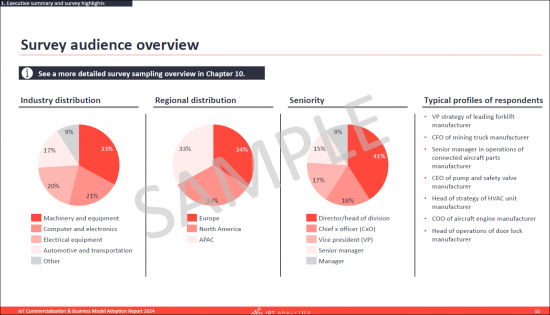
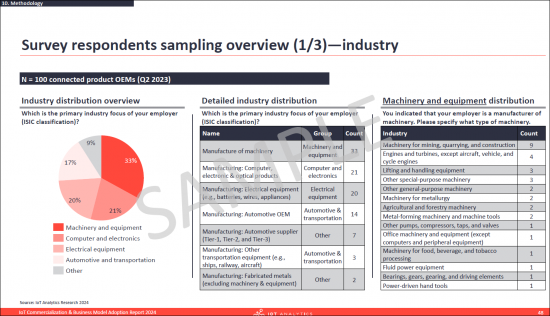
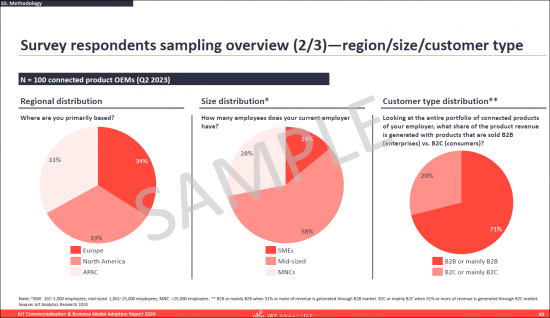
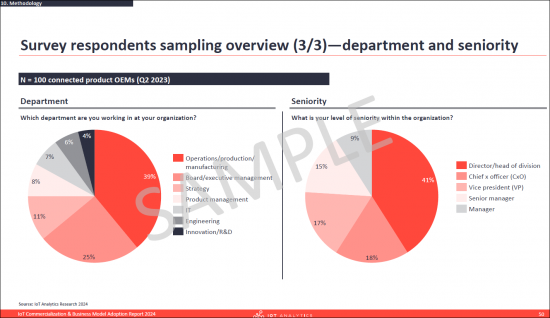
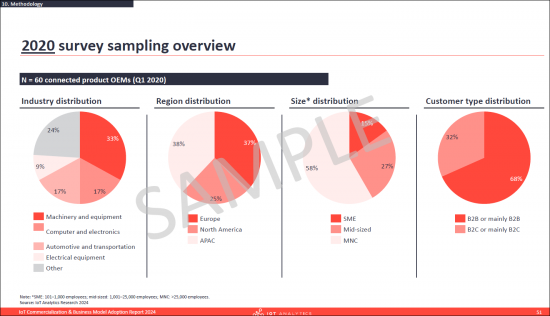
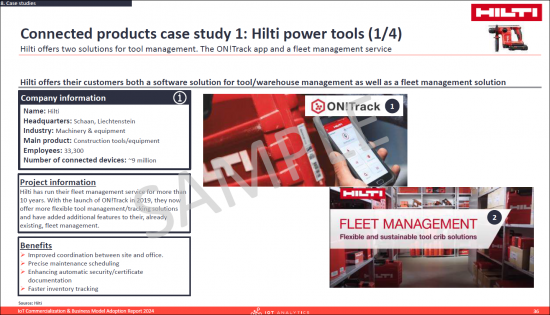
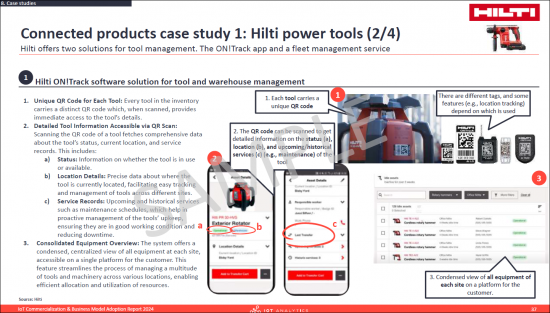
掲載企業
|
|
目次
第1章 エグゼクティブサマリー・調査ハイライト
第2章 イントロダクション
第3章 コネクテッド機器:支持の根拠
- OEM収益に対するコネクテッド製品の貢献 (1/3) - 全体/地域
- コネクテッド製品のOEM収益への貢献 (2/3) - 産業
- OEM収益に対するコネクテッド製品の貢献 (3/3) 規模/顧客タイプ
- IoT製品の価値 (1/5) - 全体
- IoT製品の価値 (2/5) - 例:顧客からの洞察の取得
- IoT製品の価値 (3/5) - 業界別
- IoT製品の価値 (4/5) - 地域、企業規模、顧客タイプ別
- IoT製品の価値 (5/5) - 部門別、年功別
- IoT製品が企業の業務をどのように強化するか (1/7) - 概要
- IoT製品が企業の業務をどのように強化するか (2/7) - セグメント別
- IoT製品が企業の業務をどのように強化するか (3/7):物理製品の製品設計/エンジニアリング
- IoT製品が企業の業務をどのように強化するか (4/7):ソフトウェアの製品設計/エンジニアリング
- IoT製品が企業の業務をどのように強化するか (5/7):フィールドサービス業務と製造。プロセス
- IoT製品が企業の業務をどのように強化するか (6/7):アフターサービスと顧客サポート
- IoT製品が企業の業務をどのように強化するか (7/7):SW/サービスを販売するための販売/マーケティングプロセス
- 例:OEMが自社の機器を接続する場合の3つの主な利点
- IoT製品の利用データの業務システムへの統合 (1/2) - 概要
- IoT製品の利用データの業務システムへの統合 (2/2) 例
第4章 IoT製品の開発
- スマートコネクテッド製品の予算編成 (1/3) - 全体コスト
- スマートコネクテッド製品の予算編成 (2/3) - コンポーネント別
- スマートコネクテッド製品の予算編成 (3/3) - コンポーネント/セグメント別
- スマートコネクテッド製品のコンポーネントの予算配分
- 各技術スタック層の調達先
- 回答者が使用している上位IoTベンダー (1/3) - 概要
- 回答者が使用している上位IoTベンダー (2/3) - 技術スタック別
- 言及されているオープンソースツール/ベンダー
- 市場投入までの時間 (1/5) - 概要
- 市場投入までの時間 (2/5) - 業界および地域別
- 市場投入までの時間 (3/5) - 発売年、ビジネスモデル、企業規模別
- 市場投入までの時間 (4/5) - 3年間の比較
- 市場投入までの時間 (5/5) - 結果の解釈
- 基本機能の開発- 概要
- セルフサービスオプションの提供
- 使用状況ダッシュボードの提供 (1/2)
- 無線 (OTA)アップデート (1/2)
- 無線 (OTA)アップデート (2/2) - 例
第5章 ビジネスモデルの開発
- 新製品と既存製品の比較 (1/2) - 概要
- 新製品と既存製品 (2/2) - 産業および地域別
- コネクテッド製品機能の価値 (1/3) - 概要
- コネクテッド製品機能の価値 (2/3) - 詳細図
- コネクテッド製品機能の価値 (3/3) - セグメント別
- 金属加工機械の接続製品
- リモートサービス/ リモートコントロール:Grupo Cimbali
- 状態監視:Trumpf
- 運用ダッシュボード:König & Bauer
- 運用ダッシュボード:Liebherr (1/3):概要
- 運用ダッシュボード:Liebherr (2/3):マシン情報
- 運用ダッシュボード:Liebherr (3/3):レポート情報
- エネルギー監視:Liebherr
- 顧客の使用状況の監視 (1/2):概要
- 顧客の使用状況の監視 (2/2):好例
- 各製品部分の収益寄与度 (1/2) - 数年間
- 各製品部分の収益寄与度 (2/2) - セグメント別
- ビジネスモデルの革新 (1/3) - 概要
- ビジネスモデルの革新 (2/3) - 詳細概要
- ビジネスモデルの革新 (3/3) - 業界の視点
- 追加のビジネスモデルの洞察- 概要
- ソフトウェアアドオンの提供と収益化- 例:UNOX
- 顧客への機器リース - 例:Tetra Pak
- 特定のパフォーマンス保証の提供- 例:Johnson Controls
- EaaS OEM採用状況 (1/2) -概要
- EaaS OEM採用状況 (2/2)-セグメント別
- EaaSを導入している企業の代表的な4つの事例
- 顧客によるEaaSの導入
- 顧客によるEaaS採用の理由
- 顧客がEaaSの導入に消極的な理由
- EaaSへのピボットを確実に成功させるために必要なアクション
- EaaSへのピボットを成功させるための追加の回答者洞察
- 例:明確な価値提案を持つ
- EaaSへの移行時によくある間違い
- EaaS対応の洞察に移行する際によくある間違い
第6章 IoT製品の商業化
- 収益化と追加保証 (1/2) - 概要
- 収益化と追加保証 (2/2) - セグメント別
- さまざまなソリューション要素の収益化 (1/3) - 今日
- さまざまなソリューション要素の収益化 (2/3) - 2年以内
- さまざまなソリューション要素の収益化 (3/3) - 予想される変化
- 概要:データの所有権とプライバシー
- 例:コネクテッド製品に影響を与えるプライバシーとセキュリティ法の例
- 顧客の採用を促進する要因
- 顧客の導入に関する懸念事項/障害 (1/2) - 概要
- 顧客の導入に関する懸念事項/障害 (2/2) -2020年以降の変更点
第7章 商業化の成功からの学び
- 成功するOEMの5つの特徴
- 成功したIoT商用化の特定
- 成功しているOEM:フリーミアムモデル別ソフトウェアアドオンに重点を置いている
- 成功しているOEM:顧客のワークフローの最適化を支援
- 例:Trumpfワークフローの最適化
- 成功しているOEM:サービス導入における顧客のハードルを理解することを優先
- 成功しているOEM:IoTデータをCRMおよびERPシステムに統合
- 成功しているOEM:IoTデータを効果的に活用し、販売とマーケティングを強化
第8章 ケーススタディ
- コネクテッド製品のケーススタディ1:Hilti power tools
- コネクテッド製品のケーススタディ2:John Deere
- コネクテッド製品のケーススタディ3:Schindler elevators
- コネクテッド製品のケーススタディ4:BMW cars
- コネクテッド製品のケーススタディ5:UNOX ovens
- Equipment-as-a-Serviceのケーススタディ1:Heller
- Equipment-as-a-Serviceのケーススタディ2:Carrier
- Equipment-as-a-Serviceのケーススタディ3:Mitsubishi
第9章 付録
第10章 調査手法
第11章 IoT Analyticsについて
206-page report that analyzes how companies commercialize smart connected IoT products, including success characteristics and patterns, possible pitfalls, case studies, and more.
About the report
The “IoT Commercialization & Business Model Adoption Report 2024” is part of IoT Analytics' ongoing coverage of Industrial IoT and Industry 4.0. The information presented in this report is based on an extensive survey, conducted in Q3 2023, of 100 OEMs of smart, connected products. The purpose of the report is to inform other market participants, most notably other OEMs that start developing their own connected IoT product and their vendors, of the process for creating such products, as well as the benefits they provide. Survey participants were selected randomly, and their knowledge was verified independently. To ensure complete objectivity, IoT Analytics did not alter or supplement any survey results and did not accept participants that were suggested by third parties. The IoT Analytics team added a number of examples to make some of the survey results more "real" for the reader (e.g., pricing examples and examples of specific connected product features introduced by some OEMs).

This publication analyses the process of commercializing smart connected IoT products along 6 main sections:
1. Making the case for connected equipment
- Revenue contribution
- Key benefits of connected equipment
- Key beneficiaries of connected equipment
2. Developing the IoT product
- Finding the budget
- Buy vs. build and top vendors used
- Taking the IoT product to market
- Developing basic features
3. Developing the business model
- Positioning the IoT product in the market
- Prioritizing the use cases and features
- Determining the revenue streams
- Innovating the business model
- Deep dive: Equipment as a Service
4. Commercializing the IoT product
- Monetizing the IoT product
- Driving adoption of the IoT product
5. Learning from successful commercialization
6. Case studies highlighting successful projects and learnings
SAMPLE VIEW







Questions answered:
- How much are connected products contributing to OEM revenue, and how is this expected to change in the future?
- How are OEMs sourcing their tech stack?
- Which vendors are being used most often for each part of the tech stack?
- How valuable have the connected products been for the organization, and which company activities are they improving upon?
- What is the necessary budget for a company to create smart, connected products from scratch?
- How are OEMs innovating their business model?
- What are the biggest factors for driving customer adoption of connected products, and what are the most important concerns/roadblocks?
- How are OEMs monetizing their solutions?
- What is the state of Equipment as a Service (EaaS) , including adoption, necessary actions to be successful when pivoting to the model, and common pitfalls to avoid?
- Which business systems are integrated with the IoT product usage data?
- What extra features are OEMs offering to their customers on top of their connected products?
- What are the six main factors that differentiate companies with more successful IoT commercializations?
- What are some connected product and EaaS case studies?
Companies mentioned:
A selection of companies mentioned in the report.
|
|
Table of Contents
1. Executive summary and survey highlights
- Report scope and organization
- Who participated in this research (selection)?
- Survey audience overview
- This report is an update of the "IoT Commercialization & Business Model Adoption Report 2020"
- Executive Summary
- Highlight: 6 key insights from the analysis performed in the report
- Highlight: 5 characteristics of successful OEMs
2. Introduction
- Starting point: OEMs can tap into nine potential sources of revenue
- Search terms related to new OEM business models are slowly but steadily trending upwards
- Conceptual approach-the more connected, the higher the value potential
- IoT enables OEMs to develop new competitive advantages
- Universal Robots-an OEM journey in six years
- Connected products drive an OEM's services business
- This report takes the reader through the journey of an OEM
3. Making the case for connected equipment
- Contribution of connected products to OEM revenue (1/3)-overall/regions)
- Contribution of connected products to OEM revenue (2/3)-industry
- Contribution of connected products to OEM revenue (3/3)-size/customer type
- Value of IoT products (1/5)-overall
- Value of IoT products (2/5)-example: getting insights from customers
- Value of IoT products (3/5)-by industry
- Value of IoT products (4/5)-by region, company size, and customer type
- Value of IoT products (5/5)-by department and seniority
- How IoT products enhance a company's operations (1/7)-overview
- How IoT products enhance a company's operations (2/7)-by segment
- How IoT products enhance a company's operations (3/7): product design/engineering of the physical product
- How IoT products enhance a company's operations (4/7): product design/engineering of software
- How IoT products enhance a company's operations (5/7): field service operations and mfg. processes
- How IoT products enhance a company's operations (6/7): after-sales services and customer support
- How IoT products enhance a company's operations (7/7): sales/marketing processes to sell SW/services
- Example: Three main benefits when OEMs connect their equipment
- Integrating IoT product usage data into business systems (1/2)-overview
- Integrating IoT product usage data into business systems (2/2)-example
4. Developing the IoT product
- Budgeting for smart, connected products (1/3)-overall cost
- Budgeting for smart, connected products (2/3)-by component
- Budgeting for smart, connected products (3/3)-by component/segment
- Budget distribution for the components of smart, connected products
- Procurement sources for each technology stack layer
- Top IoT vendors used by respondents (1/3)-overview
- Top IoT vendors used by respondents (2/3)-by tech stack (1/2)
- Top IoT vendors used by respondents (3/3)-by tech stack (2/2)
- Open-source tools/vendors mentioned
- Time to market (1/5)-overview
- Time to market (2/5)-by industry and region
- Time to market (3/5)-by launch year, business model, and company size
- Time to market (4/5)-three-year comparison
- Time to market (5/5)-our interpretation of the results
- Developing basic features-overview
- Providing self-service options
- Offering a usage dashboard (1/2)
- Over-the-air (OTA) updates (1/2)
- Over-the-air (OTA) updates (2/2)-example
5. Developing the business model
- New vs. existing product (1/2)-overview
- New vs. existing product (2/2)-by industry and region
- Value of connected product features (1/3)-overview
- Value of connected product features (2/3)-detailed view
- Value of connected product features (3/3)-by segment
- Connected products in metalworking machines
- Remote service / Remote control: Grupo Cimbali
- Condition monitoring: Trumpf
- Operational dashboard: König & Bauer
- Operational dashboard: Liebherr (1/3): Overview
- Operational dashboard: Liebherr (2/3): Machine info
- Operational dashboard: Liebherr (3/3): Report info
- Energy monitoring: Liebherr
- Monitoring customer usage (1/2): overview
- Monitoring customer usage (2/2): case in point
- Revenue contribution of each product part (1/2)-through the years
- Revenue contribution of each product part (2/2)-by segment
- Business model innovations (1/3)-overview
- Business model innovations (2/3)-detailed overview
- Business model innovations (3/3)-industry view
- Additional business model insights-overview
- Offering and monetizing software add-ons-example: UNOX
- Letting the customer lease the equipment-example: Tetra Pak
- Offering specific performance guarantees-example: Johnson Controls
- EaaS OEM adoption status (1/2)-overview
- EaaS OEM adoption status (2/2)-by segment
- Four prominent examples of companies that have introduced EaaS
- Customer adoption of EaaS
- Reasons why customers adopt EaaS
- Reasons why customers are reluctant to adopt EaaS
- Necessary actions to guarantee a successful pivot to EaaS
- Additional respondent insights for a successful pivot to EaaS
- Example: Having a clear value proposition
- Common mistakes when transitioning to EaaS
- Common mistakes when transitioning to EaaS-respondent insights
6. Commercializing the IoT product
- Monetization and additional guarantees (1/2)-overview
- Monetization and additional guarantees (2/2)-by segment
- Monetization of different solution elements (1/3)-today
- Monetization of different solution elements (2/3)-in two years
- Monetization of different solution elements (3/3)-expected change
- Overview-data ownership and privacy
- Example-privacy and security laws affecting connected products
- Factors that drive customer adoption (1/2)
- Factors that drive customer adoption (2/2)
- Customer adoption concerns/roadblocks (1/2)-overview
- Customer adoption concerns/roadblocks (2/2)-changes since 2020
7. Learning from successful commercialization
- Five characteristics of successful OEMs
- Identifying a successful IoT commercialization
- Successful OEMs focus on software add-ons with a freemium model
- Successful OEMs help their customers optimize the workflow
- Example: Trumpf workflow optimization
- Successful OEMs prioritize understanding customer hurdles in service adoption
- Successful OEMs integrate IoT data with CRM and ERP systems
- Successful OEMs effectively utilize IoT data to boost sales and marketing
8. Case studies
- Connected products case study 1: Hilti power tools
- Connected products case study 2: John Deere
- Connected products case study 3: Schindler elevators
- Connected products case study 4: BMW cars
- Connected products case study 5: UNOX ovens
- Equipment-as-a-Service case study 1: Heller
- Equipment-as-a-Service case study 2: Carrier
- Equipment-as-a-Service case study 3: Mitsubishi
